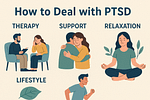Introduction: Facing PTSD with Strength and Knowledge
Post-Traumatic Stress Disorder (PTSD) is a powerful mental health condition, but so is your ability to recover. Whether you’ve faced a life-threatening event, personal loss, abuse, or chronic stress, PTSD can make daily life feel overwhelming. The good news? There are proven, empowering ways to take control and begin healing. Understanding how to deal with PDST is the first step toward reclaiming peace, purpose, and mental clarity.
Understanding PTSD: What It Means
Defining Post-Traumatic Stress Disorder
Post-Traumatic Stress Disorder (PTSD) is a mental health condition that may develop in individuals who have lived through or observed a deeply distressing or life-altering event.
Types of Trauma That Can Lead to PTSD
- Military combat
- Physical or sexual assault
- Accidents (car crashes, falls, fires)
- Natural disasters (earthquakes, floods)
- Emotional abuse or neglect
- Witnessing violence or death
Recognizing the Symptoms
- Recurrent, distressing memories or flashbacks
- Nightmares related to the trauma
- Avoidance of people, places, or situations
- Hypervigilance and exaggerated startle response
- Emotional numbness or feeling detached from others
- Difficulty concentrating or sleeping
Why Early Intervention Matters
Consequences of Untreated PTSD
Ignoring PTSD symptoms doesn’t make them go away or help on how to deal with PTSD. Without timely and effective support, the condition may progressively deteriorate and result in:
- Depression and anxiety disorders
- Substance misuse
- Relationship breakdowns
- Job instability
- Suicidal thoughts or actions
How PTSD Impacts the Brain and Body
PTSD alters the amygdala (fear center), hippocampus (memory processing), and prefrontal cortex (decision-making). This rewiring affects both mental and physical health, causing chronic stress, fatigue, and inflammation.
Therapeutic Approaches to PTSD Recovery
Cognitive Behavioral Therapy (CBT)
CBT helps individuals reframe harmful thought patterns. It’s structured, goal-oriented, and widely recognized for helping people understand their trauma and replace fear-driven thinking with healthier beliefs.
Eye Movement Desensitization and Reprocessing (EMDR)
EMDR uses eye movements to help the brain work through painful memories. It’s particularly effective for people who feel stuck in past trauma.
Exposure Therapy
This form of therapy gradually exposes individuals to trauma-related cues in a safe setting, reducing fear and avoidance behaviors over time.
Medical Treatments and Medications
Antidepressants and Anti-Anxiety Medications
Doctors may prescribe SSRIs like sertraline or paroxetine, which help regulate mood and anxiety. These can be an effective part of a broader treatment plan when seeking help on how to deal with PTSD.
Pros and Cons of Medication
Pros:
- Reduces anxiety and depression symptoms
- Improves focus and sleep
- Makes therapy more manageable
Cons:
- Potential side effects
- Not a standalone cure
- Requires monitoring and adjustment
Self-Help Techniques That Make a Difference
Daily Mindfulness and Meditation
Mindfulness helps break the loop of intrusive thoughts. Practices such as deep breathing and body scans can help you feel more present and centered.
Journaling to Process Emotions
Writing about your trauma can unlock hidden emotions, provide clarity, and offer a release without judgment.
Breathing Exercises and Grounding
When panic strikes, simple grounding exercises like the 5-4-3-2-1 technique can help bring you back to the present moment.
Building a Support System for Healing
Talking to Trusted Friends and Family
Don’t isolate. Sharing your experience when you’re ready can reduce shame and help others understand your journey.
Benefits of Group Therapy
Hearing others’ stories in a safe environment validates your own and fosters community healing.
Lifestyle Changes That Promote Mental Health
Nutrition and Brain Health
Foods rich in omega-3s, antioxidants, and B vitamins boost brain function and reduce inflammation.
Physical Activity and PTSD Relief
Physical activity boosts serotonin and endorphin levels, which naturally improve mood. Engaging in walking, swimming, or yoga can be beneficial exercises.
Sleep Improvement Techniques
Good sleep hygiene includes:
- Sticking to a regular schedule
- Limiting screen time before bed
- Creating a calm, dark sleep space
Managing Triggers and Flashbacks
Recognizing Personal Triggers
Triggers can be visual, auditory, or emotional cues. Identifying them helps you prepare for and reduce reactions.
Techniques to Stop a Flashback in Its Tracks
- Touch something cold (like an ice cube)
- Name 5 things you can see or hear
- Use a calming scent (lavender oil, for example)
When to Seek Professional Help On How To Deal with PTSD
Warning Signs That You Shouldn’t Ignore
- Suicidal thoughts
- Self-harming behaviors
- Complete emotional shutdown
- Inability to perform daily tasks
What to Expect from a Mental Health Professional
A licensed therapist will assess your history, guide you through treatment options, and support you in a safe, non-judgmental environment.
FAQs About How to Deal with PTSD
1. Is PTSD permanent?
No. With the right treatment, many people recover and live fulfilling lives.
2. Can I manage PTSD on my own?
Self-help is important, but professional support often leads to faster, more stable recovery.
3. Is PTSD a sign of weakness?
Not. PTSD is a response to trauma, not a reflection of character or strength.
4. How long does it take to recover?
Recovery times vary. Some may improve in months, while others require years of consistent support.
5. Can children or teens have PTSD?
Yes. They may show different symptoms such as regression, nightmares, or increased clinginess.
6. What’s the first step I should take?
Talk to a mental health professional or your doctor. Opening up is the first act of courage in recovery.
Conclusion: Reclaiming Control and Finding Peace
Living with PTSD can seem like being lost in a storm, but the path to recovery is always within reach. With options like therapy, healthy habits, peer support, and medication, there are multiple ways to move toward healing.

